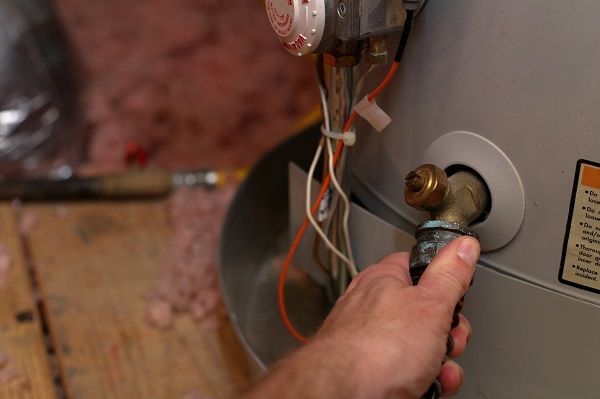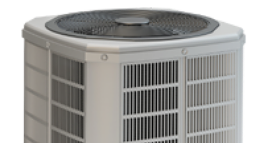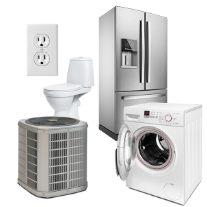You can drain your tank water heater yourself with just a garden hose, flathead screwdriver, a bucket, and some time. Draining your water heater minimizes sediment buildup. This buildup can damage your water heater over time, so it’s good to get rid of it. Here’s how you can drain your water heater.
Turn Off the Gas or Electricity
If you have a gas heater, turn off the gas. There should be a shutoff valve for the gas supply lines to your house, or your furnace may have a setting on the thermostat to cut off the gas supply to the tank.
If you have an electric heater, go to the fuse box and turn off the breaker that controls the water heater.
Turn Off the Thermostat
The water heater’s thermostat is usually located near the bottom of the heater. If you have a gas heater, turning off the thermostat may also turn off the pilot light. If so, don’t forget to relight the pilot when you’re finished draining the tank. Your gas water heater should have instructions for how to restart the pilot light, and it’s usually pretty easy.
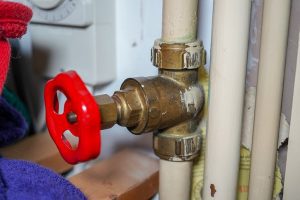
Turn Off the Cold Water Supply to the Tank
This step is easy to overlook, and it can make quite a mess or even hurt you if you forget to do it! Make sure you’ve shut off your cold water supply to the tank before going any further.
Wait for the Tank Water to Cool (30-120 Minutes)
The water in your water heater could be scalding. If you try to drain scalding water, you’re likely to burn yourself. By waiting for the water to cool (about 30 minutes, but as many as 2 hours), you can more safely drain it.
Check for Leaks
Once you’ve turned off the above elements and let the water cool, it’s time to check for leaks. If you notice any dripping or standing water near your water heater, or any water near connected valves or pipes, you likely have a leak. A leak means higher water bills. It also means that your heater won’t run as efficiently as possible.
At this point, you may need to research, find, and contact a professional to assess the leak. Or, if you have a 2-10 Home Buyers Warranty (2-10) Home Service Plan, you can file your claim through us and we’ll dispatch a quality, approved professional to assess your leak.
Open a Hot Water Tap in the House
If your water heater doesn’t have any leaks, you can move to the next step: opening a hot water tap in your house. Doing this prevents a vacuum from forming and makes draining the tank easier. Keep the tap open until you’re finished draining the tank.
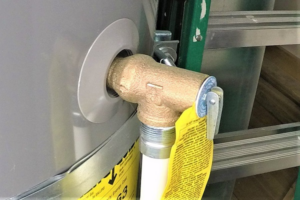
Picture from The Spruce
Open the Temperature and Pressure (T&P) Release Valve
Be careful as you do this. If you didn’t wait for the tank to cool, the hot water released may be scalding.
The T&P valve will be either high on the side or on the top of the water heater. First, make sure it works. If it isn’t functioning properly, pressure can build inside, causing your water heater to burst. Here’s how to test it.
- If your T&P drainpipe doesn’t have a PVC attachment pointed at a drain, place a bucket underneath to catch any water.
- Lift the T&P lever part-way, allowing it to snap back into place. Don’t lift it all the way. You should hear a gurgling noise as the valve sends some water to the drainpipe.
- If no water comes out or you don’t hear any gurgling, replace it immediately, as this is a sign that pressure could be building to a critical point.
Attach a Hose to the Water Heater’s Drain
If the T&P release valve is working correctly, connect a strong garden hose to your water heater’s drain line, which looks like a spigot near the bottom of the tank. Use a strong hose. Cheap garden hoses can become soft when hot water runs through them, causing leaks.
Run the hose to your basement drain or run it outside the house.
Turn On All the Hot Water Faucets in Your House
This prevents vacuums from forming. Don’t be alarmed if the water only trickles out. That’s normal.
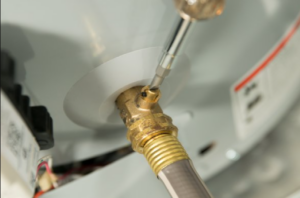
Picture from Whirlpool
Open the Water Heater’s Drain Valve, Allowing the Tank to Empty
You may need your flathead screwdriver to do this. Water and sediment will begin to drain through the hose you attached to the water heater’s drain. Let water continue to flow through the hose until you see only clear water coming out. This may take some time.
Close Drain Valve & Turn On the Cold Water Supply to the Water Heater
Once clear water flows from the hose, you can close the drain valve and turn on the cold water supply. Then, all you need to do is:
Turn the Electricity or Gas Back On
Relight the Pilot Light or Restore Power to the Water Heater
Turn Your Water Heater’s Thermostat Back Up
Close the Hot Water Taps Throughout the House
That’s it! You’ve successfully drained your water heater, lengthening its life.

Do More With 2-10
Of course, water heaters rarely fail on a schedule, and unexpected is expensive. To protect yourself against the wear and tear your water heater will face, consider a 2-10 Home Service Plan. A 2-10 Home Service Plan makes protecting your home more affordable.


